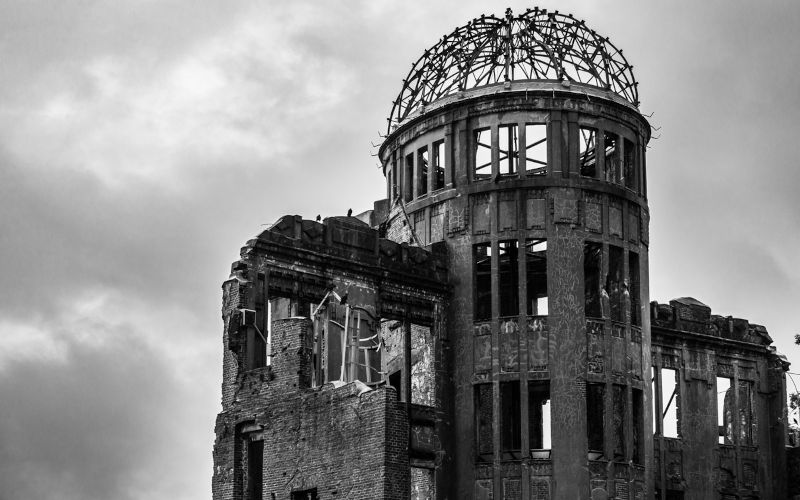Blinded by the light
May 16, 2024
Richard Flanagan has done us a favour. His recent book, Question 7, takes us back to the creation of atomic bombs, and to their use against people, in Hiroshima and Nagasaki. Those bombs played an indirect but pivotal role in Flanagan’s family. They are directly pivotal in humanity’s story. After many decades of habituation to abstract talk of nuclear warfare, Flanagan reminds us of what a nuclear bomb does to people and why no more should ever be used.
Warning: some descriptions to follow may be distressing for some people, and ought to be distressing to generals, politicians and military ‘security’ experts.
One of several threads in the book is the story of the Hungarian Jewish physicist Leo Szilard. Szilard made some of the key advances that brought the atomic bomb to reality, and his great tragedy is that he desperately wanted it not to be used. He was an early refugee from Hitler’s Europe and was terrified Nazi Germany might develop an atomic bomb before anyone else.
As Germany collapsed into defeat in April 1945 it became evident the Germans did not have the bomb. They had tried, but were missing some key insights, and Hitler in any case did not want to divert the enormous resources it would have taken.
At Szilard’s urging, with help from Einstein, President Roosevelt had been persuaded in 1939 to develop the bomb. After Germany surrendered early in 1945 Szilard saw no need for the bomb, as there was no prospect of the Japanese developing one. He tried to reach Roosevelt again but Roosevelt died. Szilard tried to get a memorandum to President Truman but Truman’s henchmen failed or refused to pass on the message.
Szilard and other scientists wanted to stage a demonstration explosion with Japanese and international observers, so they would understand the vast destructive power of the new device. They urged the creation of an international treaty to prevent their further development, and to ban them. Their pleas went unheeded.
When the bomb ignited over Hiroshima, it was as though a piece of the sun was released on Earth. Light and heat more intense than any part of the Earth had ever experienced was released. Perhaps 60,000 people died within seconds, though the number may have been much greater.
People directly beneath were evaporated. People nearby would have been charred. People were instantly blinded, their exposed parts cooked. Everything flammable was ignited, creating a giant firestorm that sucked remains of people, buildings, everything into the rising mushroom cloud. A shock wave blasted almost every building down.
Thousands of blinded people stumbled out of the inferno with long strips of skin peeling off, wailing for help, for water, for their mothers. Some died in agony within minutes, others died within hours and days. Peoples’ irradiated bodies failed them within hours, days, months, years, suffering new kinds of ailments. Crew of the American plane that dropped the bomb reported seeing a seething, boiling, dark and evil cloud spreading along the ground, across the city and into nearby valleys. It would have been highly radioactive.
The flash of the bomb was so intense the bomber crew reported seeing right through their bodies. Whatever small fraction of the light penetrated into the bomber and their clothing was enough to reveal their internal flesh and bones. President Truman revealed years later that to him the bomb was just a bigger weapon, and so he used it to win the war against Japan. Debate has raged ever since whether that was the best decision. A conventional invasion of Japan would probably have cost many more lives and dragged out for another year or more. On the other hand the nuclear genie was released.
Szilard had been inspired by one of H. G. Wells’ lesser-known books, in which Wells foresaw the immense energy from atomic nuclei being used for bombs, bombs that could destroy a city, bombs that would destroy human civilisation. The bomb technology was seized upon by the generals and so-called security experts. Other countries developed them, vastly more powerful hydrogen bombs were developed, tens of thousands of bombs were made and they still number about fifteen thousand, easily sufficient to end civilisation and most life on Earth.
Somehow we survived the ‘cold war’, the ‘balance of terror’, the doctrine of ‘mutually assured destruction’, MAD. Zealots claim that proves the wisdom of their strategy, but we know there was a big dose of luck the bombs were not used. Luck is not forever, someday it will run out.
Nearly eighty years later the zealots are promoting a proxy war with Russia and military confrontation with China. Neither country poses a serious threat to us if we leave them alone. The zealots are paranoid extremists, they are self-interested participants in the military industrial complex, they are blind and they will be the death of us if we leave them in control.

